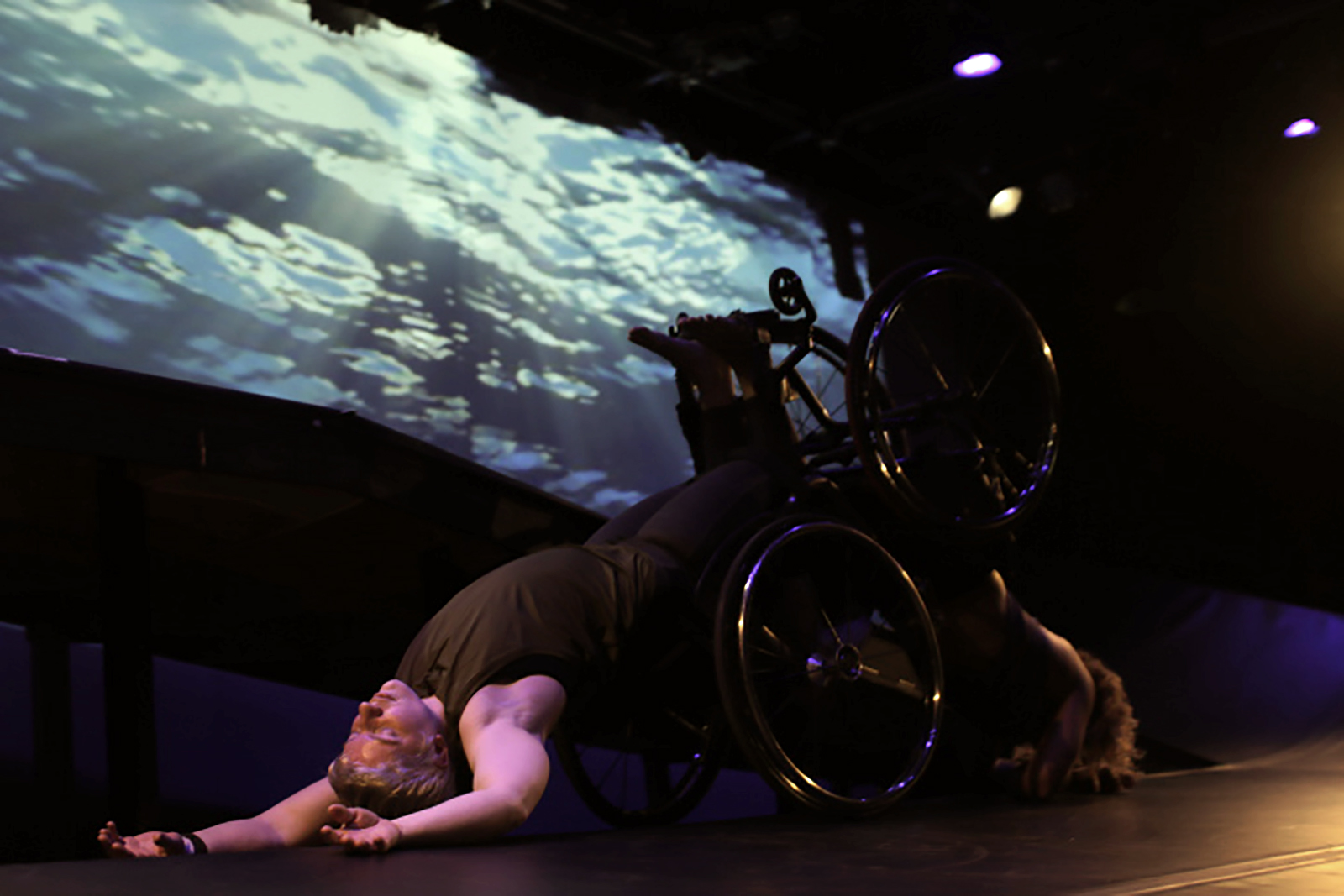How Alice Sheppard Is Elevating Dance To Peerless New Heights
FYI: The artist is hosting a Whitney Study Session this Friday.
Alice Sheppard and Laurel Lawson of Kinetic Light perform Descent (2017). Courtesy the author for NEW INC.
Alice Sheppard is a big fan of asking, “what if?” The question, in part, stems from a civic determination to entertain alternatives: to the ways we understand dance, navigate space, and perhaps most importantly, to the ways we comprehend the disabled body. But more often than not, her line of inquiry tends to lead to a project.
With over a decade of experience in integrated dance—along with a latent dive into choreography in 2012—Sheppard has, over the years, formed a compelling space at the nexus of dance and technology. In this time, Sheppard co-founded the company Kinetic Light with fellow performer Laurel Lawson and video artist Michael Maag, amassed a growing online community through threads like #askwheelchairdancer and #rampfail, and directed the construction of a custom-built ramp stage with the support of engineers at Olin College.
The artist keeps busy. During the latter-half of this month alone, Sheppard is slated to host a series of public rehearsals at Gibney Dance in midtown Manhattan, where she and her stage are taking up residence. On Friday, at the invitation of Sasha Wortzel, Sheppard will lead a Whitney Museum Study Session on Melvin Edwards’s sculpture, Pyramid Up and Down Pyramid (1969/1970), which is currently on view in “An Incomplete History of Protest."
“I encountered her work this past summer when she participated at an event at The 8th Floor,” Wortzel told NEW INC during a phone conversation. “It was a roundtable discussion about disability and contemporary art, and thinking beyond how institutions make themselves more accessible, but thinking about accessibility in terms of methodology as artists, curators, and academics. One thing that resonated with me was when she was talking about ramps and how, so often when ramps are built into spaces, they’re very ugly, utilitarian, and practical. They don’t give a sense of pleasure or joy.”
Melvin Edwards, DescPyramid Up and Down Pyramid (1969/1970).
Courtesy Alice Sheppard.
Pleasure happens to be a recurring element in Sheppard's output. Her most recent project with Laurel Lawson, Descent, imagines a fraught romance between the goddesses Venus and Andromeda—a narrative interpretation that involves themes of isolation, gravity, and desire. Bisected into two parts, the dance is performed on the very ramp stage Sheppard helped construct, which is, in turn, activated by video projections provided by Michael Maag.
In an interview with NEW INC, Sheppard said her forthcoming Study Session will think about the dynamics of the human body as a way of drawing and moving in space. “I’m looking for disability as an aesthetic,” Sheppard said. “That means understanding disability culture, understanding disability history, and also disability practices—and connecting with the practices of other disabled art-makers, and being in conversation with them. I don’t want my work to be simply about presenting the disabled body. I want people to understand how disability creates and expresses the movement and beauty of the work.”
Recommended: Marquee: We Give Live Performances A More Accessible Life
Sheppard further emphasized that situating her pieces within the context of other disabled dancers, artists, and thinkers helps eschew reductive tendencies in framing her work. The artist cited painter Riva Lehrer, writers Georgina Kleege and Eli Clare, and theorists Rosemarie Garland Thomson and Simi Linton as relevant leaders enriching the dialogue. Choreographer and performer Heidi Latsky, who invited Sheppard to present at Danspace Project earlier this March, noted that Sheppard's approach is "delving into some exciting vocabulary."
“This is a very new form for New York City," Latsky said. "You don't really see it a lot. In my work—I‘ve been doing it for ten years—it’s like banging on the doors to get that kind of exposure, so it's really exciting to see something that's so virtuosic happening in the States, but especially in New York.”
Kinetic Light, Descent (2017). Courtesy the author for NEW INC.
Despite the artist's appeals to reimagine disability as an aesthetic, Sheppard notes that gaps in knowledge typically position her as an unwitting translator. By the time her audiences acquire the requisite register needed to access the piece, the conversation has moved away from the work and onto points of entry.
“People are focused on disability as a lack of ability,” Sheppard said. “They tend to concentrate on what they think is or should be possible according to their understanding of the disabled body. Then, when they see my work, they see movement that is unexpected to them. Because it is unexpected, people call my work risky. But actually, some of the things that look risky or dangerous aren’t. It's just that people don't have the level of cultural literacy and familiarity with disability and dance, so they make judgments based on their own level of experience—which isn't the same as ours.”
“That said,” Sheppard conceded, “there is an element of risk in my work; but there is an element of risk in most dance works. We practice. We fail. We practice. We nail it.”
Alice Sheppard will be leading a Study Session at the Whitney Museum of American Art this Friday, December 15 from 7 PM to 9 PM. The event is free with admission.
Author: Rain Embuscado



